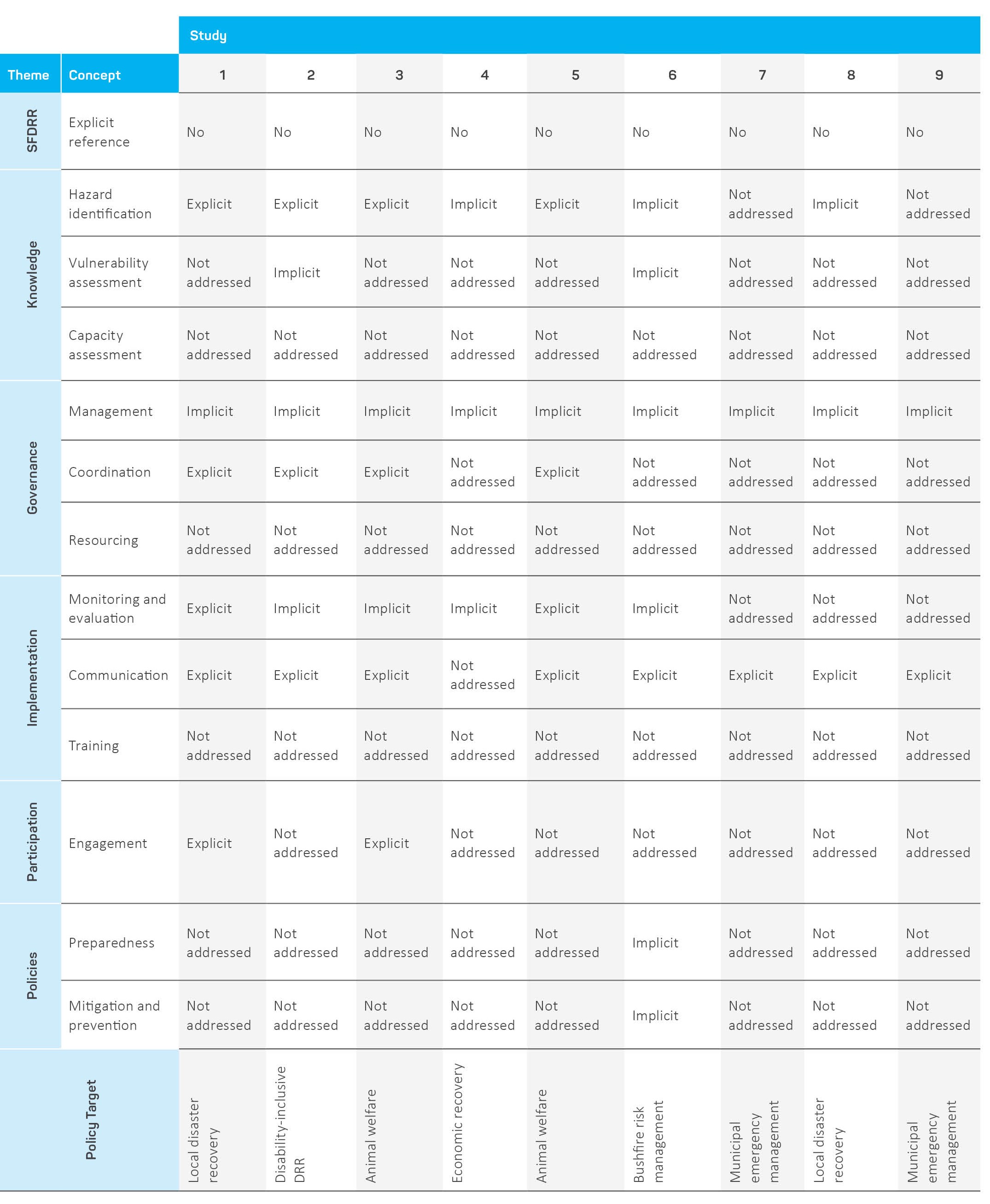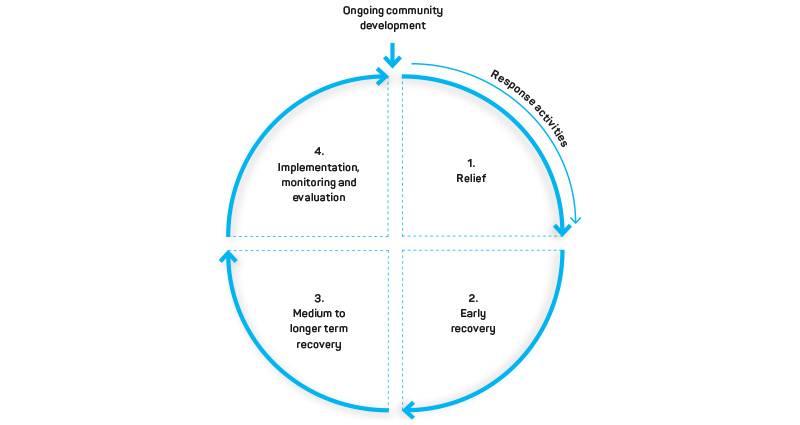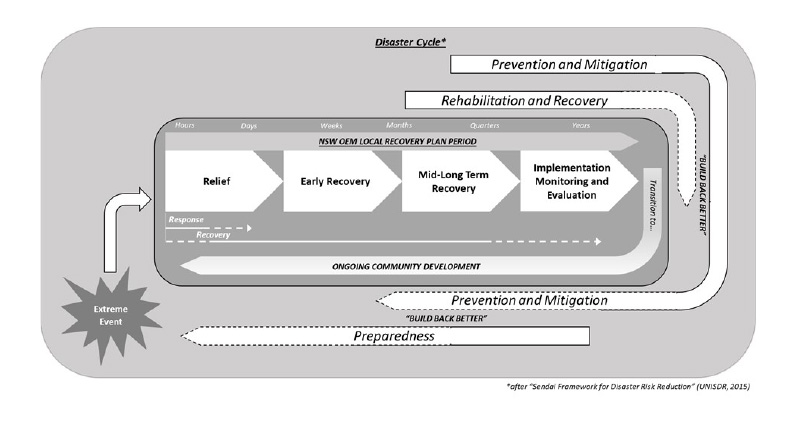Abstract
Since the 2015 ratification of the Sendai Framework for Disaster Risk Reduction 2015-2030, disaster risk reduction (DRR) has been part of Australia’s policy environment. However, the extent to which it has affected policy and procedure is questionable. Emergency services organisations, as first responders, should be enthusiastic advocates for DRR, both in terms of their role during the response and recovery phases and as facilitators of risk reduction through mitigation and preparedness activities. DRR dividends include a reduction in the likelihood that extreme events would become disasters, better inclusion of marginalised sections of the community and reduced demand for scarce resources during extreme events. Yet despite the obvious benefits of this paradigm, emergency services organisations in Australia are yet to fully embrace this change. A possible explanation may be found in the policy and procedures that drive the actions of both them and the communities they serve. Recent postgraduate studies have examined the extent of incorporation of DRR principles into recovery planning, planning for animal welfare, disability inclusion during emergency response and others. These studies suggest that DRR is poorly understood, rarely included in policy and procedures and the potential benefits are lost, to the detriment of all. A proposed alignment of disaster-related policy (in the widest sense) with the disaster cycle integrates emergency service know-how into ‘normal community development’ activities and offers a positive way forward for DRR to become second nature.
Introduction
The world faces accelerated numbers of extreme weather events, each likely to be of increasing severity, primarily because of climate warming. Though the localised consequences over the longer term may not yet be clear it is evident that they will be negative, placing increased demand on the resources required to deal with them. There is growing agreement that increased attention to DRR is necessary to reduce the socio-economic and socio-environmental consequences of extreme events.
In 2015, Australia joined 186 nations in ratifying the Sendai Framework for Disaster Risk Reduction 2015-2030 (Sendai Framework) (UNISDR 2015). In doing so, it embraced the 4 priority areas and 7 global targets associated with the framework. Although these were expressed in aspirational terms, leaving each nation to contextualise their implementation locally, countries were expected to report periodically on their progress, both in terms of disaster metrics (frequency, impact, investment in initiatives) and strengthened risk governance measures, principal among which would be national and local DRR strategies.
DRR in Australia had changed with the introduction of the National Strategy for Disaster Resilience (NSDR) (Commonwealth of Australia 2011) and accelerated after the release of the National Disaster Risk Reduction Framework (NDRRF) (Commonwealth of Australia 2018). This has worked its way through to state and territory legislatures, being reflected in new and revised policies and organisations. In New South Wales, this has resulted in the closure of the Office of Emergency Management and many of its functions transferred into the new agency of Resilience NSW. Parallel changes can be found in other jurisdictions, tailored to local conditions and history.
The global community is conscious that 2023 marks the midpoint of the Sendai Framework. Several students in the Master of Disaster Resilience and Sustainable Development program at the University of Newcastle undertaking their capstone research project investigated the effects that Australia's ratification of the framework has had on practice in disaster and development. These students come from diverse disciplines and professional backgrounds and their interests are equally diverse. Nevertheless, their research has followed similar, rigorous and logical paths, revealing surprisingly similar patterns and outcomes. This paper analyses the policy findings from their research.
Research approach, data collection and analysis
The research has been rationalised in the following way: Australia is a signatory to the Sendai Framework and is therefore morally (if not legally) obligated to make progress on its central tenets. This is detectable in policy, and particularly policy changes, which ought to be congruent with the Sendai Framework, subject to the policies' foci and contexts. Importantly, they should reduce disaster risk by incorporating contextually appropriate best practice. A comprehensive understanding of the relevant literature enables construction of a framework of concepts, together with definitions and characteristics that describe best practice DRR in relation to the focal topic. In turn, this can be used to thematically analyse the related policy(ies) and practice documents to:
- identify the presence or otherwise of each desirable concept
- the extent to which they are addressed, relative to global best practice.
Each research project used some sort of systematic approach to review the literature, including specifying databases to be searched, key search terms (and their justification), date delimitations, and inclusion/exclusion criteria. The papers have been screened for relevance, by title, keywords and review of abstract. The remainder were thematically coded and analysed, with the results being synthesised into main themes (concepts) and detailed subthemes (where appropriate), all being linked to the sources. These were defined by the researchers in their own words, with each main theme being accompanied by synonym words/phrases (since policy makers may use different terms to define similar ideas). This conceptual framework has become the tool used to analyse policy.
During 2019–21, a total of 12 studies were conducted and assessed and 9 were judged to be of publishable quality (Table 1). Six were produced by students who were employed by either emergency service organisations or local governments with the remainder being full-time students of DRR. In some instances, a single relevant policy document was analysed (e.g. the NSW Local Disaster Recovery Plan template) while in others, multiple implementations of a single policy were investigated (e.g. all publicly available Municipal and Local Emergency Management Plans in Australia). In all cases, the investigation was conducted as a policy analysis using qualitative thematic analysis of the content. Together, the 9 studies form the data for this paper, each of which is mapped against a previously developed, generic framework of DRR themes and concepts (Brewer & Conant 2021). Generalisation is confined to this set of studies, though broader implications for policy and practice are later conjectured.
Results
Given that some of the students' studies explicitly looked for evidence of policy alignment to the Sendai Framework while others examined policy for implicit alignment to the principles contained within it, the first step was to look for overt reference to the framework. This was particularly sought in the introduction, or in any overarching enabling policy, since this should be a reliable indicator of subsequent intent. Where none was found, the students’ own Sendai Framework-aligned conceptual frameworks were used to gauge congruence with Sendai-inspired principles. Since the policies tended to be diverse in focus and their DRR measures were highly contextualised, the development of synonymous themes became important to identify policy-driven actions that were congruent with DRR principles. Table 1 summarises the results.
Table 1: Data analysis summary.


Superficially, the results seem self-explanatory. On one level, all policies directing context-relevant arrangements during times of emergency or disaster can be said to be overarched by national legislation, particularly the NSDR (Commonwealth of Australia 2011) and the NDRRF (Commonwealth of Australia 2018). Although there is no guarantee that they will have been revised since these strategies/frameworks were introduced, the NSDR has existed for over a decade and ought to have had some effect. Despite this, none of the policies reviewed made overt reference to the Sendai Framework.
Both hazard identification and disaster risk management were widely found, largely because most of the policies analysed were related to specific hazards (e.g. bushfire) or groups at risk (e.g. disabled persons) and the policies were the mechanism by which these would be managed. Policies relating to vulnerable sections of communities or fixed infrastructure similarly implied a level of vulnerability, though none of the examples in this study contained explicit mechanisms for assessing vulnerability. None of the policies contained capacity assessment requirements, either of facilities/enacting organisations or of communities, though in some cases they referred to other policy and procedures, compliance with which would require capacity assessment.
The governance domain was, unsurprisingly, one of the stronger DRR elements across all 9 studies, mainly because the existence of the policy was an implicit acknowledgment of the management of associated risk, though coordination (with actors) was either explicitly articulated or completely absent. In relation to resourcing, none of the policy documents contained any mechanism detailing budgetary allocations or control. That said, some referred to sources of emergency funding controlled by other actors.
Direction of implementation was patchier. Communication was the only area of strength although this was usually restricted to defining lines of reporting. Some policies required ongoing monitoring and evaluation, particularly where implementation was expected to stretch over months or years. A few policies implicitly acknowledged that monitoring and evaluation would be required. All of the policies were silent in relation to training.
Engagement with communities was an area of widespread weakness and few policies addressed the issue. Moreover, the few that did include forums for community engagement (e.g. community resilience networks) did not explain how they were to be formed, maintained or scaled up during times of emergency.
Similarly, DRR-specific policy actions in relation to mitigation, preparedness and prevention was essentially absent from all policies analysed.
Discussion and implications
DRR is intended to delay, and even prevent, extreme events overwhelming local capacity to cope. To ensure this happens, the Sendai Framework and the NDRRF stress the need for integration of resources across the whole of the disaster cycle (in New South Wales known as the ‘PPRR’ or Prevention, Preparation, Response, Recovery Cycle). Table 1 hints at the extent to which this isn't being reflected in the policy domain. When it indicates reasonable levels of inclusion of coordination and communication within policies, this is overwhelmingly restricted to the organising entity affected by the policy or the temporary governance structures set up in times of emergency. No consideration is given to ongoing and systemic inter-organisational collaboration or dialogue. These overwhelmingly response-related policy documents have implications for ongoing ‘business as normal’ operations. The absence of preparedness, mitigation and prevention actions should be viewed as a missed opportunity.
A clue to this disconnection between DRR intent and disaster policy action might lie in the history and evolution of organisational structures and the policies that regulate them, particularly if the Disaster Recovery Cycle (NSW Government 2018) (Figure 1) is taken into consideration. In essence, while it implicitly covers all 4 stages in the PPRR cycle, it constrains all response agency involvement to the response and recovery stages, implying that prevention, mitigation and preparedness all take place within that time from when recovery is deemed to have been completed, through to the next extreme event. This part of the OEM recovery cycle is euphemistically termed, ‘Ongoing Community Development’ and includes, among other things, all decisions related to rural and urban land-use, environmental planning, community, health and business development. Given that resilience and DRR are still firmly located within the emergency management domain, it is perhaps hardly surprising that dialogue between emergency services agencies and organisations devoted to ongoing community development is limited.

Figure 1: NSW OEM recovery operations model.
In a world where the frequency and intensity of extreme events is on the rise, the probability that emergency services agencies will become overwhelmed is also increasing. Many of the community development decisions that are made on a regular basis increase disaster risk that goes unnoticed and uncommented. While it is ultimately the public who pay the price for these decisions (socially, environmentally and economically), emergency services agencies also experience increased risk (largely reputational, though also to their members during response activities). It is sobering to reflect that while emergency service agencies often have a legislated duty to review and comment on such decisions and their consequences, they seldom do. Revising the disaster recovery cycle to include all stages in PPRR could give policy makers permission to design integrative activities that are fit-for-purpose for DRR. Figure 2 shows a proposed new model for recovery operations in the DRR cycle. This could extend to risk-informed input into development decisions and planning and exercising for events that overwhelm local coping capacities; the very definition of a disaster.

Figure 2: Proposed NSW recovery operations and DRR cycle (Brewer & Conant 2021).
References
Brewer G & Conant A 2021, Towards an Integrative Model of Disaster Recovery through Disaster Risk Reduction: A Recovery Model for New South Wales, Australia. Academia Letters, Article 4142. doi:10.20935/AL4142.
Commonwealth of Australia 2011, National Strategy for Disaster Resilience. At: www.homeaffairs.gov.au/emergency/files/national-strategy-disaster-resilience.pdf [10 June 2022].
Commonwealth of Australia 2018, National Disaster Risk Reduction Framework. At: www.homeaffairs.gov.au/emergency/files/national-strategy-disaster-resilience.pdf [10 June 2022].
NSW Government 2018, New South Wales State Emergency Management Plan. Office of Emergency Management, NSW Department of Justice. Sydney, Australia.
United Nations Office of Disaster Risk Reduction (UNDRR) 2015, Sendai Framework for Disaster Risk Reduction 2015-2030, United Nations Office of Disaster Risk Reduction: Geneva. At: www.undrr.org/publication/sendai-framework-disaster-risk-reduction-2015-2030.


